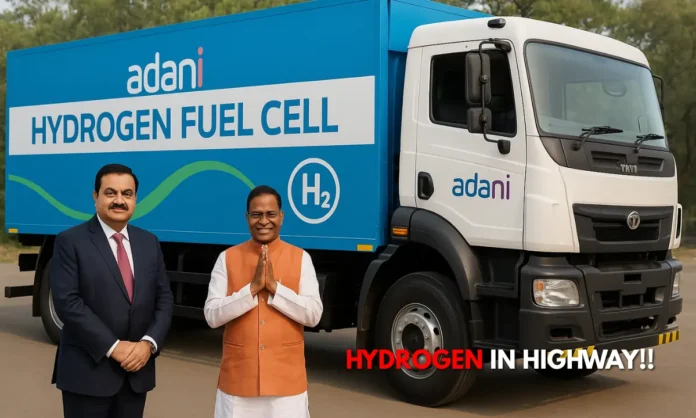SUMMARY
- Adani Group launches India’s first hydrogen-powered cargo truck in Chhattisgarh, signaling a shift toward sustainable mining logistics.
- The truck, with a 200-km range and 40-ton load capacity, aligns with Adani’s larger decarbonisation blueprint and partnership with global tech players.
- This initiative coincides with Chhattisgarh’s push to become a national model for green industrial transformation amid power sector reforms.
Hydrogen on Wheels: Adani’s New Bet on Clean Cargo
India’s corporate giant Gautam Adani has once again entered uncharted territory—this time by steering the country’s heavy cargo transport into the hydrogen age. On May 10, 2025, Adani Group flagged off India’s first hydrogen fuel cell truck in Raipur, Chhattisgarh. The truck will carry coal from the Gare Pelma III Block to the state’s power plant and is touted as the first step in replacing diesel vehicles across Adani’s vast logistics operations. The move dovetails with a broader industrial pivot to green fuel and aims to make the company’s mining operations cleaner, quieter, and more efficient.
Chhattisgarh Chief Minister Vishnu Deo Sai, who inaugurated the vehicle, noted the broader impact: “Chhattisgarh is not just meeting India’s power needs—it’s setting benchmarks in sustainable infrastructure.” The deployment comes at a critical moment as India faces dual pressures: expanding energy demand and the global race to decarbonise industrial supply chains.
From partnerships with international energy tech firms to outfitting the trucks with three hydrogen tanks and smart navigation tools, this is more than a green showpiece. It is part of a deep strategic commitment to reframe the country’s industrial transport ecosystem—and perhaps Adani’s brand itself.
#AdaniEnterprises, the flagship company of the @AdaniOnline Group, flagged off India’s first hydrogen fuel cell truck to promote cleaner transportation. These hydrogen-powered trucks will gradually replace diesel vehicles used in the company’s logistics operations. In… pic.twitter.com/U4DrFKFLNw
— Upendrra Rai (@UpendrraRai) May 10, 2025
Engineering a Shift: Inside the Adani Hydrogen Fuel Truck Rollout
- Hydrogen truck has a 200-km range, supports up to 40-ton load, and emits only water vapor.
- Developed in partnership with both Indian and international clean energy tech companies.
- Part of a broader digital, solar, and automation transformation at Adani-operated coal mines.
Gautam Adani’s hydrogen truck isn’t merely a vehicle—it’s a mobile manifesto. Designed to operate like a diesel truck in range and payload but with none of its carbon cost, the vehicle reflects an evolved Adani brand attempting to neutralize past controversies with cutting-edge environmental commitments.
Vinay Prakash, CEO of Adani’s Natural Resources division, outlined the broader vision: “This is more than clean cargo. It’s model mining. We’re bringing in solar arrays, tree transplanters, autonomous dozers, and smart surveillance to make our logistics chain low-emission and data-optimised.”
The pilot project in Chhattisgarh, involving the state-run Chhattisgarh State Power Generation Company Limited, offers a testbed for deeper public-private synergy. The Gare Pelma III coal block, previously a conventional mining site, is now being retrofitted as a low-carbon benchmark. Whether this sets the template for other energy conglomerates remains to be seen—but the groundwork is being laid.
From Optics to Outcomes: The Caution Behind the Commendation
- Critics argue hydrogen fuel in India still lacks a supportive infrastructure for wide-scale rollout.
- Hydrogen production remains costly and largely dependent on fossil-fuel-powered electrolysis.
- Experts warn that optics-driven pilots can derail if not followed by policy and infrastructure alignment.
While the launch of the Adani hydrogen fuel truck has received widespread attention and praise, experts warn against premature celebration. India still lacks a commercially viable green hydrogen production ecosystem. Much of the available hydrogen is grey—produced using natural gas—undermining the environmental benefits when upstream emissions are counted.
Critics have also raised concerns over the economic viability of hydrogen fuel cell trucks, which are currently costlier than their electric and diesel counterparts. Without a strong green hydrogen policy framework and incentives for production and distribution, some analysts believe the project risks becoming another PR experiment rather than a scalable solution.
Moreover, industry watchdogs have urged the government to ensure transparency and third-party auditing, especially given past scrutiny of Adani’s environmental track record. For the promise of clean logistics to become real transformation, pilot programs like these must scale quickly, reliably, and inclusively.
Final Verdict: Gears of Progress or Green Facade?
Adani’s deployment of India’s first hydrogen fuel truck is both a symbolic and operational leap into cleaner industrial futures. Whether it serves as a springboard for mass-scale hydrogen transport or remains a niche branding exercise will depend on infrastructure development, policy backing, and sustained investment. What is clear, however, is that India’s industrial giants are now being measured not just by output, but by their carbon footprint. In this recalibration, Adani may have just nudged the starting line.


